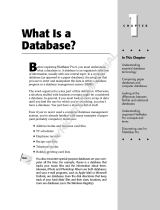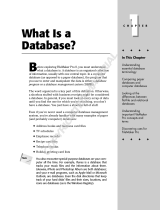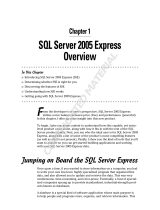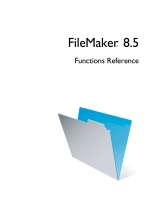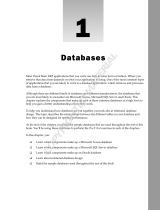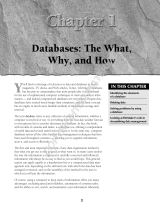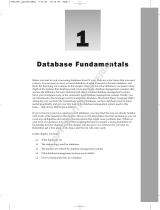Page is loading ...

File
Maker
®
8
ODBC and JDBC Developer’s Guide

©
2004
-2005
FileMak
er
, Inc.
All Rights Reserv
ed.
FileMak
er
, Inc.
5201 P
atrick Henry Dri
v
e
Santa Clara, California 95054
FileMak
er is a trademark of FileMak
er
, Inc., re
gistered in the
U.S. and other countries, and ScriptMak
er and the fi
le folder logo
are trademarks of FileMak
er
, Inc.
FileMak
er documentation is cop
yrighted.
Y
ou are not authorized
to mak
e additional copies or distrib
ute this documentation
without written permission from FileMak
er
.
Y
ou may use this
documentation solely with a v
alid licensed cop
y of FileMak
er
softw
are.
All persons and companies listed in the e
xamples are purely
fi
ctitious and an
y resemblance to e
xisting persons and companies
is purely coincidental.
Credits are listed in the
Ackno
wledgements document pro
vided
with this softw
are.
F
or more information, visit our web site at www
.fi
lemak
er
.com.
Edition:
0
1

Contents
Chapter 1
Introduction
7
About this guide
7
Using ODBC and JDBC with FileMaker
7
Using a FileMaker database file as a data source
8
Networking requirements
9
Using FileMaker Pro as a client application
9
U
pdating files from previous versions
9
I
f you previously shared a FileMaker database file as a data source
9
If you previously used FileMaker
Pro as a client to access a data source
10
Chapter 2
Using ODBC to share FileMaker data
11
About ODBC
11
Using the ODBC client driver
12
Accessing a FileMaker database file - overview
12
A
ccessing a FileMaker database file from a Windows application
13
Installing the ODBC client driver (Windows)
13
Specifying ODBC client driver properties for a FileMaker DSN (Windows)
13
Verifying access via ODBC (Windows)
15
Accessing a FileMaker database file from a Mac
OS application
15
Installing the ODBC client driver (Mac
OS)
15
Configuring the ODBC client driver (Mac
OS)
16
Specifying ODBC client driver properties for a FileMaker DSN (Mac
OS)
16
Verifying access via ODBC (Mac
OS)
17
Chapter 3
Using JDBC to share FileMaker data
19
About JDBC
19
Using the JDBC client driver
19
Installing the JDBC client driver
20
About the JDBC client driver
20
Using a JDBC URL to connect to your database
20
Specifying driver properties in the URL subname
22
Verifying access via JDBC
23

4 FileMaker ODBC and JDBC Developer’s Guide
Chapter 4
Supported standards 25
Support for Unicode characters 25
SQL statements and clauses 25
SELECT statement 25
DELETE statement 28
INSERT statement 29
UPDATE statement 30
CREATE TABLE statement 30
ALTER TABLE statement 31
CREATE INDEX statement 31
DROP INDEX statement 32
FROM clause 32
WHERE clause 33
GROUP BY clause 33
HAVING clause 33
UNION operator 33
ORDER BY clause 34
FOR UPDATE clause 34
SQL aggregate functions 35
SQL expressions 35
Field names 36
Constants and literals 36
Exponential/scientific notation 37
Numeric operators 37
Character operators 37
Date operators 37
Relational operators 38
Logical operators 39
Functions 39
Operator precedence 41
ODBC Catalog functions 42
JDBC Meta Data functions 42
Appendix A
Mapping FileMaker fields to ODBC data types 43
Appendix B
Mapping FileMaker fields to JDBC data types 45

|
Contents 5
Appendix C
ODBC and JDBC error messages 47
ODBC error messages 47
ODBC driver error messages 47
ODBC Driver Manager error messages 47
SequeLink Client error messages 47
SequeLink Server error messages 48
Data source error messages 48
JDBC error messages 48
JDBC driver error messages 48
SequeLink Server error messages 48
Data source error messages 49
Index 51

6 FileMaker ODBC and JDBC Developer’s Guide

Chapter 1
Introduction
Welcome to the FileMaker
®
ODBC and JDBC Developer’s Guide. This guide explains concepts and details
to help you share FileMaker data with other applications, using ODBC (Open Database Connectivity) and
JDBC (Java Database Connectivity). This guide also documents how the ODBC and JDBC client drivers,
when used with FileMaker
Pro and FileMaker Server Advanced, support the industry standards for ODBC,
JDBC, and SQL (Structured Query Language).
You can use FileMaker Pro, FileMaker Pro Advanced, or FileMaker Server Advanced, to create and test
your database solution. You can then share your FileMaker database solution as a data source with ODBC-
and JDBC-compliant applications, or access other ODBC data sources using your FileMaker database
solution as a client application.
About this guide
1 This document contains information to access and share data using ODBC and JDBC with
FileMaker
Pro 8, FileMaker Pro 8 Advanced, and FileMaker Server 8 Advanced only. For information
on using ODBC and JDBC with previous versions of FileMaker
Pro, download documents from
www.filemaker.com/odbc.
1 This guide assumes that you are familiar with the basics of using ODBC and JDBC, and constructing
SQL queries. Refer to a third-party book for more information on these topics.
1 For step-by-step information on FileMaker Pro features, including accessing other data sources via
ODBC, refer to FileMaker Pro Help.
1 FileMaker Pro documentation uses the term web publishing to refer to databases that users can access on
the Internet or on an intranet using a web browser.
1 This guide uses “FileMaker Pro” to refer to both FileMaker Pro and FileMaker Pro Advanced, unless
describing specific FileMaker Pro Advanced features.
1 This guide uses “FileMaker Server” to refer to FileMaker Server 8 Advanced, which supports sharing
FileMaker database files with other applications using ODBC and JDBC.
Important You can download PDFs of FileMaker 8 documentation from www.filemaker.com. Any updates
to this document are also available from www.filemaker.com/odbc.
Using ODBC and JDBC with FileMaker
ODBC and JDBC are application programming interfaces (APIs). These APIs give client applications a
common language for interacting with a variety of data sources and database services, including
FileMaker
Pro and FileMaker Server.
All applications that support ODBC and JDBC recognize a basic subset of SQL statements. Working with
SQL, you can use other applications (like spreadsheets, word processors, and reporting tools) to view,
analyze, and modify FileMaker data.

8 FileMaker ODBC and JDBC Developer’s Guide
SQL is passed through the ODBC and JDBC interfaces to the FileMaker host of the data source, performing
queries such as
SELECT first_name, last_name FROM customers WHERE city='Paris' and
making updates such as the creation of a new record with INSERT INTO customers (first_name,
last_name) VALUES ('Jane','Smith').
Using a FileMaker database file as a data source
You can use FileMaker Server to host a FileMaker database file as a data source, sharing your data with
other applications using ODBC and JDBC. FileMaker
Server allows up to 50 connections and supports local
access (same computer) and remote access (both for middleware such as web servers, and for remote client
access from desktop productivity applications).
You can use FileMaker Pro to host a FileMaker database file as a data source, sharing your data with client
applications using ODBC and JDBC. FileMaker
Pro allows up to five connections and supports local access
(same computer) only.
The xDBC plug-in component you need for sharing your data with other applications is automatically
installed with FileMaker
Server and FileMaker Pro.
To access a hosted FileMaker database file, you need to install the corresponding ODBC or JDBC client
driver. The client drivers are available through a separate installation on your FileMaker CD in the folder
\xDBC. You can also download the latest versions of the client drivers and PDFs of FileMaker 8
documentation from www.filemaker.com/odbc. If you’ll be hosting a FileMaker database file using
FileMaker
Server, make the client drivers available to remote users.
If your FileMaker database solution uses more than one FileMaker database file, all of the database files
must be on the same computer.
Client applications sometimes use different terminology for accessing a data source. Many applications
have menu items with names such as
Get external data or SQL query. Review the documentation or Help that
comes with your application.
Chapter 4, “Supported standards,” describes the SQL statements that the ODBC and JDBC client drivers
support when used with FileMaker Pro and FileMaker Server. For more information on constructing SQL
queries, refer to a third-party book.
Important If you disable ODBC/JDBC sharing after it's already been on, a data source hosted by
FileMaker
Server or FileMaker Pro immediately becomes unavailable. The database administrator doesn’t
have the capability to alert ODBC and JDBC client applications about the data source’s availability (the
administrator can communicate only with FileMaker database file clients). No errors are reported, and the
client application should notify users that the data source is not available and transactions cannot be
completed. If a client application attempts to connect to an unavailable FileMaker database file, a message
explains that the connection failed. If you host your FileMaker database file on Mac
OS X 10.3, restart
FileMaker
Pro or FileMaker Server before you re-enable ODBC/JDBC sharing (restarting is not necessary
in Mac
OS X 10.4).
See the Installing FileMaker ODBC and JDBC Client Drivers guide to install the driver files needed for
accessing a FileMaker data source.

Chapter 1
|
Introduction 9
Limitations with third-party tools
Microsoft Query Wizard
1 In a FileMaker data source, you cannot access table or column names that use High ASCII or double-
byte characters. Instead, use Microsoft Query and manually enter the characters, enclosed in double
quotation marks.
Microsoft Access
1 In a FileMaker data source, you cannot access table or column names that use High ASCII or double-
byte characters.
1 You cannot link to a FileMaker data source; however, you can import the FileMaker data source.
Networking requirements
You need a TCP/IP network when using FileMaker Server 8 to host a FileMaker database file as a data
source over a network. FileMaker
Pro 8 supports local access (same computer) only.
Using FileMaker Pro as a client application
You can use FileMaker Pro as an ODBC client application, interacting with data sources on the same
computer or over a network.
Limitations with third-party tools
Microsoft SQL Server
1 When you export decimal, float, money, or numeric data to a FileMaker database file, the auto-enter field
option Calculated value is set in the database. The option truncates values to zero decimal places using the
calculation
Truncate(fieldname;0). If you deselect the option in the created database and then repeat the
export, the auto-enter field option remains deselected.
Updating files from previous versions
FileMaker Pro 8 can open files created in earlier versions of FileMaker. See the Converting FileMaker
Databases from Previous Versions
guide for information.
Note FileMaker Server 8 can host FileMaker Pro 8 and FileMaker Pro 7v3 databases files.
FileMaker
Server 8 cannot host or convert earlier versions of FileMaker Pro database files.
If you previously shared a FileMaker database file as a data source
If you used LDAC (Local Data Access Companion) or RDAC (Remote Data Access Companion) to share a
database file in previous versions, you’ll need to make two changes. First, you need to set up users to belong
to an account that has the extended privilege of
Access via ODBC/JDBC (as part of the account’s privilege
set). Then, you need to enable your FileMaker
Server or FileMaker Pro host for ODBC/JDBC sharing (in
FileMaker
Pro, choose Edit menu > Sharing > ODBC/JDBC and turn on sharing).

10 FileMaker ODBC and JDBC Developer’s Guide
See FileMaker Pro Help for details about sharing via ODBC/JDBC, and for setting up accounts and
privilege sets.
Note In previous versions of FileMaker Server and FileMaker Pro, you needed to create only one DSN
(Data Source Name) for the host application when configuring a driver for access via ODBC. The one DSN
allowed you to access any of your FileMaker database files as a data source. Beginning with
FileMaker
Server 7 and FileMaker Pro 7, you must create a DSN for each individual FileMaker database
file you want to access as a data source. If you have previously set up access through one DSN that allows
tables to be spread among several FileMaker database files, you’ll need to consolidate those tables into a
single database file (or create several DSNs).
If you previously used FileMaker Pro as a client to access a data source
The drivers you configured to access the data source should still work. See www.filemaker.com/odbc for
links to third-party vendors providing updated drivers. Additionally, Windows includes client drivers, such
as SQL Server driver, with the operating system.
Important On Mac OS, OpenLink iODBC drivers conflict with the drivers provided in earlier versions of
FileMaker. If you install the OpenLink iODBC drivers, you can no longer use the Text, Oracle, or SQL
Server drivers included in earlier versions of FileMaker
Pro.
See FileMaker Pro Help for details about using FileMaker Pro to access other data sources via ODBC.

Chapter 2
Using ODBC to share FileMaker data
Use the ODBC client driver to connect to a FileMaker data source from another application. The application
that uses the ODBC client driver can directly access the data in a FileMaker database file. In Windows, the
FileMaker ODBC client driver is
DataDirect 32-BIT SequeLink 5.4. In Mac OS, the FileMaker ODBC client
driver is
ivslk18.dylib.
You can also use FileMaker Pro as a client application, interacting with records from another data source
via ODBC using SQL. See FileMaker
Pro Help for details about accessing a data source via ODBC.
About ODBC
ODBC is an API that enables applications to access data from many database management systems. ODBC
gives client applications a common language for interacting with data sources and database services.
All applications that support ODBC recognize a common subset of statements. SQL lets you use other
applications (like spreadsheets, word processors, and reporting tools) to view, analyze, and modify
FileMaker data. See
chapter 4, “Supported standards,” for the SQL statements, functions, and expressions
that the ODBC client driver supports.
Your application can talk directly to a FileMaker database file by using the ODBC client driver. Your SQL
statements are delivered to the FileMaker host of the database file and the results of those statements are
sent back to you. If you use FileMaker
Server to host a FileMaker database file as a data source, the database
file can be located on another machine (the server machine) connected to the network, while your client
application is located on your machine (the client machine). This is referred to as a client/server
configuration.
Client
Application
Oracle
Driver
Manager
SQL Server
ODBC Driver
ODBC Client
Driver
Oracle
ODBC Driver
FileMaker
Microsoft
SQL Server
ODBC components

12 FileMaker ODBC and JDBC Developer’s Guide
Using the ODBC client driver
You can use the ODBC client driver with any ODBC-compliant application. Sharing your FileMaker
database file as a data source, you can:
1 perform mail merges with Microsoft Word
1 create charts with Microsoft Excel
1 move FileMaker data to a DBMS like Microsoft SQL Server
1 further analyze your FileMaker data with query or reporting tools to create charts, construct ad-hoc
queries, and perform drill-down analysis
1 create a Microsoft Visual Basic application that shares information with FileMaker Pro
To share a FileMaker database file as a data source, use FileMaker Pro to define accounts that will need
access to the database file. Then, control access to the database file by assigning privilege sets to the
accounts, including the extended privilege of access via ODBC/JDBC. Finally, enable the FileMaker
Server
or FileMaker
Pro host application to share data via ODBC/JDBC.
For details, see FileMaker Pro or FileMaker Server Help.
Important The ODBC client driver replaces the FileMaker Pro ODBC driver released with a previous
version of FileMaker. If you have previously set up access to a FileMaker data source using the older driver,
you’ll need to re-define access by using and configuring the new driver.
Accessing a FileMaker database file - overview
From an ODBC-compliant application, you can construct SQL queries to access a FileMaker database file.
The ODBC client driver must be installed on the computer generating the SQL query.
To access a FileMaker database file:
1. In FileMaker Pro, review the privilege sets you’ve assigned to accounts that will access the database file.
Accounts that need access must use a privilege set with the extended privilege of Access via ODBC/JDBC.
2. Enable the FileMaker Server (via FileMaker Server Admin) or FileMaker Pro host application to share
data via ODBC/JDBC.
FileMaker Server Admin (Windows): Choose Action menu > Properties > Clients tab, click Enable Client
Services
, then select Allow ODBC and JDBC connections.
FileMaker Server Admin (Mac OS): Click the Configure button, click the Clients tab, then select Allow
ODBC and JDBC connections
.
FileMaker Pro (Windows): Choose Edit menu > Sharing > ODBC/JDBC and set ODBC/JDBC Sharing to On.
FileMaker Pro (Mac OS): Choose FileMaker Pro menu > Sharing > ODBC/JDBC and set ODBC/JDBC
Sharing
to On.
3. Make sure the FileMaker database file you want to access is hosted and available.
If your FileMaker database solution uses more than one FileMaker database file, all of the database files
must be on the same computer.

Chapter 2
|
Using ODBC to share FileMaker data 13
4. Connect to the FileMaker data source.
Client applications sometimes use different terminology for accessing a data source via ODBC. Many
applications have menu items with names such as
Get external data or SQL query. Review the
documentation or Help that comes with your application for details.
5. Construct and execute a SQL query in the client application.
Each FileMaker database file that is open and set up for access is a separate data source (you create a
DSN for each individual FileMaker database file you want to access as a data source).
Each database can have one or more tables. FileMaker fields are represented as columns. The complete
field name, including any non-alphanumeric characters, displays as the column name.
Note In Windows, Microsoft Access can import only 32 or fewer fields at one time via ODBC from a
FileMaker database file. If your database file has more than 32 fields, import them in increments of 32.
Important If you host your FileMaker database file on Mac OS, client drivers cannot access database names
or table names that contain upper-ASCII, double-byte, or Japanese characters. If your FileMaker database
file uses these characters, create a second database and use only ASCII characters for the filename and table
names. In the second database, create a file reference that points to the data in your original database file.
Share both files with ODBC/JDBC, but use the second database file when defining the DSN.
Accessing a FileMaker database file from a Windows application
Installing the ODBC client driver (Windows)
The ODBC client driver is available through a separate installation on the FileMaker Server Web Publishing
CD and the FileMaker
Pro CD in the folder \xDBC\ODBC Client Driver Installer. You can also download
the latest version of the ODBC client driver and PDFs of FileMaker ODBC documentation from
www.filemaker.com/odbc.
For installation instructions, see Installing FileMaker ODBC and JDBC Client Drivers, which is available
as a PDF document on the FileMaker
Pro CD in the folder \xDBC\Electronic Documentation, and in the
folder \English Extras\Electronic Documentation where you installed FileMaker Server.
Specifying ODBC client driver properties for a FileMaker DSN (Windows)
Create a DSN for each individual FileMaker database file you want to access as a data source (in previous
versions of FileMaker
Server and FileMaker Pro, you created only one DSN for all FileMaker database files
hosted by the application). The DSN identifies the FileMaker ODBC client driver, the host application
(FileMaker
Server or FileMaker Pro), and the FileMaker database file you’re accessing as a data source.
To set up or change ODBC client driver properties:
1. Open the ODBC Data Source Administrator control panel.
In the Windows Control Panel, choose Administrative Tools > Data Sources (ODBC).
In Windows XP, Administrative Tools appear in the Performance and Maintenance category.
2. Click the System DSN tab.
If you set up your data source as a User DSN or File DSN, click the corresponding tab.

14 FileMaker ODBC and JDBC Developer’s Guide
3. Click Add.
If you’re changing the properties of an existing data source, select the data source, click Configure, and
skip to
step 6.
4. Choose DataDirect 32-BIT SequeLink 5.4 from the list of drivers.
If the driver is not listed in the ODBC Data Source Administrator, look for the (Default) entry of the
registry key
HKEY_LOCAL_MACHINE\SOFTWARE\ODBC\ODBCINST.INI\ODBC Drivers using Regedit
(choose
Start menu > Run > Regedit). The Data for this entry should be (value not set). If instead you see
a blank string, right-click
(Default), choose Delete, and click Yes to confirm. This resets the entry to
(value not set). Uninstall and reinstall your ODBC client driver to see it in the ODBC Data Source
Administrator.
5. Click Finish.
The DataDirect SequeLink for ODBC Setup dialog appears, with the General tab selected.
6. For Data Source Name, type a name that will be meaningful to others accessing the FileMaker data source.
An additional Description is optional.
Be sure Use LDAP is cleared. No translator .DLLs are included with the ODBC client driver (so clicking
Translate will not allow you to configure an ODBC translator).
7. For SequeLink Server Host, enter the location of your data source.
If you’re connecting to a FileMaker database file hosted by FileMaker Pro on your local machine, type
localhost (or 127.0.0.1).
If you’re connecting to a FileMaker database file hosted by FileMaker Server over a network, type the
IP address of FileMaker Server.
8. For SequeLink Server Port, type 2399.
9. For Server Data Source, type the filename of the FileMaker database file you’re using as a data source
(don’t type the filename extension).
If you’ve enabled sharing via ODBC/JDBC in the FileMaker Pro or FileMaker Server host application,
click the button to the right of
Server Data Source to display the filenames of currently open FileMaker
database files for you to choose from.
If your database name contains spaces, replace them with the escape characters %20. For example,
serverdatasource=MY%20DATABASE.
10. Click OK to save your data source information.
If you’re sharing another FileMaker database file, return to step 3 and set up the database file as a data
source.
11. Click OK to close the ODBC Data Source Administrator dialog box.
Important When configuring a FileMaker data source, you must specify 2399 as the SequeLink Server Port.

Chapter 2
|
Using ODBC to share FileMaker data 15
Verifying access via ODBC (Windows)
To verify that you’ve correctly configured the ODBC client driver to access the FileMaker data source:
1. Open the ODBC Data Source Administrator control panel.
In the Windows Control Panel, choose Administrative Tools > Data Sources (ODBC).
In Windows XP, Administrative Tools appear in the Performance and Maintenance category.
2. Click the System DSN tab.
If you set up your data source as a User DSN or File DSN, click the corresponding tab.
3. Choose the FileMaker data source that you previously configured.
The data source name you originally entered will appear under Name, and DataDirect 32-BIT SequeLink 5.4
will appear as the
Driver.
4. Click Configure.
The DataDirect SequeLink for ODBC Setup dialog box appears.
5. Click Test Connect.
You are prompted to enter your FileMaker account name (in Database User Name) and password (in
Database Password).
If the connection is OK, you’ll receive the message Connection test was successful. If the connection fails:
1 Make sure the FileMaker database file is hosted and available.
1 Update or correct your connection information.
1 Make sure your FileMaker account uses a privilege set with the extended privilege of Access via ODBC/
JDBC
.
1 Verify that the FileMaker Pro or FileMaker Server host application has been set up for sharing via
ODBC/JDBC.
Accessing a FileMaker database file from a Mac OS application
If you build custom applications, use version 3.52.1 of the iODBC headers and libraries. Applications built
with version 3.51 might not be able to load the client driver.
Installing the ODBC client driver (Mac OS)
The ODBC client driver is available through a separate installation on the FileMaker Server Web Publishing
CD and the FileMaker
Pro CD in the folder \xDBC\ODBC Client Driver Installer. You can also download
the latest version of the ODBC client driver and PDFs of FileMaker ODBC documentation from
www.filemaker.com/odbc
To install the ODBC client driver, copy the file SequeLink.bundle to either your System or User library. If you
don’t have an /ODBC folder, create one manually:
Library
Copy SequeLink.bundle to this
folder:
System /Library/ODBC
User /Users/<user>/Library/ODBC

16 FileMaker ODBC and JDBC Developer’s Guide
For additional information, see Installing FileMaker ODBC and JDBC Client Drivers, which is available
on the FileMaker
Pro CD in the folder \xDBC\Electronic Documentation, and in the folder \English
Extras\Electronic Documentation where you installed FileMaker Server.
Configuring the ODBC client driver (Mac OS)
Configure the client driver using the ODBC Administrator bundled with the iODBC driver manager
software recommended for your client application. If you require the OpenLink ODBC Administrator, it is
bundled with the ODBC-JDBC Lite Bridge download available on the OpenLink web site.
The client driver has been tested with the following ODBC Administrators:
1 OpenLink ODBC Administrator 3.52.1 (available from OpenLink Software)
1 Apple ODBC Administrator 1.0.1 (available with Mac OS 10.3)
When configuring the client driver, you’ll be prompted to provide a brief description and the path to the
driver file:
The ODBC Administrator also allows you to optionally define keywords and a Setup File path, but the client
driver does not need that information.
Specifying ODBC client driver properties for a FileMaker DSN (Mac OS)
Create a DSN for each individual FileMaker database file you want to access as a data source (in previous
versions of FileMaker
Server and FileMaker Pro, you created only one DSN for all FileMaker database files
hosted by the application). The DSN identifies the FileMaker ODBC driver, the location of the host
application, and the FileMaker database file you’re accessing as a data source.
Important The ODBC client driver for Mac OS does not support upper-ASCII, double-byte, or Japanese
characters in database names or table names. If your FileMaker database file uses these characters, create a
second database and use only ASCII characters for the filename and table names. In the second database,
create a file reference that points to the data in your original database file. Share both files with ODBC/
JDBC, but use the second database file when defining the DSN.
If you copied SequeLink.bundle
to this library: Use this driver path during configuration:
/Library/ODBC /Library/ODBC/SequeLink.bundle/Contents/MacOS/ivslk18.dylib
/Users/<user>/Library/ODBC /Users/<user>/Library/ODBC/SequeLink.bundle/Contents/MacOS/
ivslk18.dylib

Chapter 2
|
Using ODBC to share FileMaker data 17
Additionally, you’ll need to specify these keyword values for the DSN:
Important If you attempt to add a DSN with the ODBC Administrator and receive the message Could not load
the driver or translator setup library
, download and install the ODBC-JDBC Lite Bridge (m6I5jzzz.dmg) from
OpenLink’s web site. The download provides an ODBC Administrator that allows you to successfully
create a DSN. See www.filemaker.com/odbc for links to additional details.
Verifying access via ODBC (Mac OS)
The OpenLink ODBC Administrator allows you to verify that you’ve correctly configured the ODBC client
driver to access the FileMaker data source.
Keyword Value
Host If you’re connecting to a FileMaker database file hosted by FileMaker Pro on your local
machine, type localhost (or 127.0.0.1).
If you’re connecting to a FileMaker database file hosted by FileMaker Server over a network,
type the IP address or hostname of FileMaker Server.
Port Type 2399.
ServerDataSource Type the filename of the FileMaker database file you’re using as a data source (don’t type the
filename extension). If your database name contains spaces, replace them with the escape
characters
%20. For example, ServerDataDource=MY%20DATABASE. Double-byte characters
are not supported.

18 FileMaker ODBC and JDBC Developer’s Guide

Chapter 3
Using JDBC to share FileMaker data
If you’re a Java programmer, you can use the JDBC client driver with any Rapid Application Development
(RAD) tool to visually create a Java application or applet that connects to a FileMaker data source. The Java
application or applet that uses the JDBC client driver can directly access the data in a FileMaker database
file.
About JDBC
JDBC is a Java API for executing SQL statements, the standard language for accessing relational databases.
JDBC is a name and not an acronym—although it is thought of as standing for “Java Database Connectivity”
because it is the Java equivalent for ODBC. JDBC is a low-level interface, which means that it is used to
call SQL commands directly. It is also designed to be used as a base for higher level interfaces and tools.
Your Java applet or application can talk directly to a FileMaker database file by using the JDBC client driver.
Your SQL statements are delivered to the FileMaker host of the database file and the results of those
statements are sent back to you. If you use FileMaker
Server to host, the FileMaker database file you’re
using as a data source can be located on another machine (the server machine) connected to the network,
while your Java applet or client application is located on your machine (the client machine). This is referred
to as a client/server configuration.
Using the JDBC client driver
You can use the JDBC client driver with a Java compiler or RAD tool to connect with your database while
you build the code for your Java application or applet. After the Java application or applet has been created,
the JDBC client driver must be present with the files or included within the code in order for the application
or applet to communicate with the database.
To use the JDBC client driver, your Java application or applet must register the driver with the JDBC driver
manager and you must specify the correct JDBC URL from within the application or applet. You need the
JDBC URL to make the connection to the database.
DBMS proprietary protocol
Java
application
JDBC driver
FileMaker
Client machine Database server

20 FileMaker ODBC and JDBC Developer’s Guide
Installing the JDBC client driver
The JDBC client driver is available through a separate installation program on the
FileMaker
Server Web Publishing CD and the FileMaker Pro CD in the folder \xDBC\JDBC
Client
Driver Installer. The driver is packaged as a Java archive file (with the .jar filename extension)
containing a collection of class files. You can also download the latest version of the JDBC client driver (for
Windows or Mac
OS) and PDFs of FileMaker JDBC documentation from www.filemaker.com/jdbc.
For installation instructions, see Installing FileMaker ODBC and JDBC Client Drivers, which is available
as a PDF document on the FileMaker
Pro CD in the folder \xDBC\Electronic Documentation, and in the
folder \English Extras\Electronic Documentation where you installed FileMaker Server.
About the JDBC client driver
The JDBC client driver provides partial support for the JDBC 3.0 specification. For links to additional
details, see www.filemaker.com/jdbc. Also see the
SequeLink Developer’s Reference available at
www.datadirect.com.
The JDBC client driver is designed to work with the Java Development Kit (JDK) 1.4. It is a Type 4 driver
— a native protocol, pure Java driver that converts JDBC calls directly into the network protocol used by
FileMaker. This type of driver offers all the advantages of Java including automatic installation (for
example, downloading the JDBC driver with an applet that uses it). The driver will work with JDK 1.3 and
Java
2 as long as you only use JDBC 1.2 calls in a Java 2 environment
The driver class and main entry point for the driver is named:
com.ddtek.jdbc.sequelink.SequeLinkDriver
Important The JDBC client driver replaces the FileMaker JDBC driver released with a previous version of
FileMaker. If you have previously set up access to a FileMaker data source using the older driver, you’ll
need to re-define access by using and configuring the new driver.
Using a JDBC URL to connect to your database
In Java, most resources are accessed through URLs (Uniform Resource Locators). A JDBC URL is used to
identify the database so the JDBC client driver can recognize and establish a connection with the database.
The JDBC URL consists of three main parts separated by colons:
jdbc:<subprotocol>:<subname>
The first part in the JDBC URL is always the JDBC protocol (“jdbc”). The subprotocol is the driver name
or the mechanism that supports multiple drivers. For the JDBC client driver, the subprotocol is
sequelink.
The subname is the IP address of the machine that is hosting the FileMaker data source.
Registering the JDBC client driver and connecting to a FileMaker data source (an example)
Here is an example using JDBCTest that:
1. Registers the JDBC client driver with the JDBC driver manager
2. Establishes a connection with the FileMaker data source (the JDBC URL is jdbc:sequelink://
17.184.17.170:2399)
/
